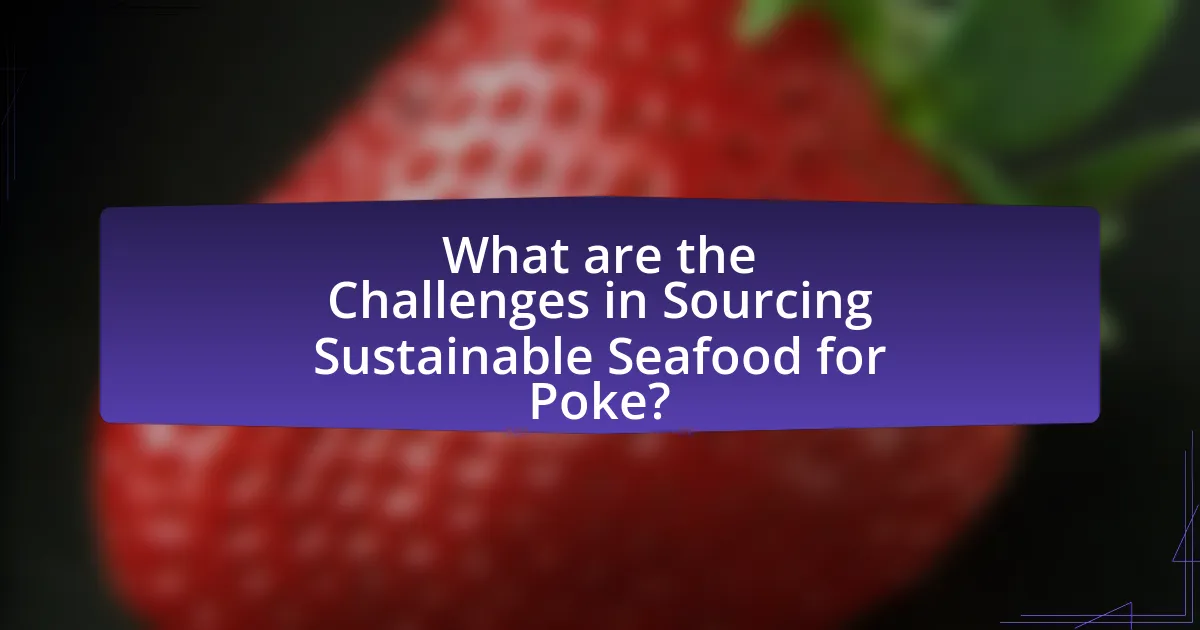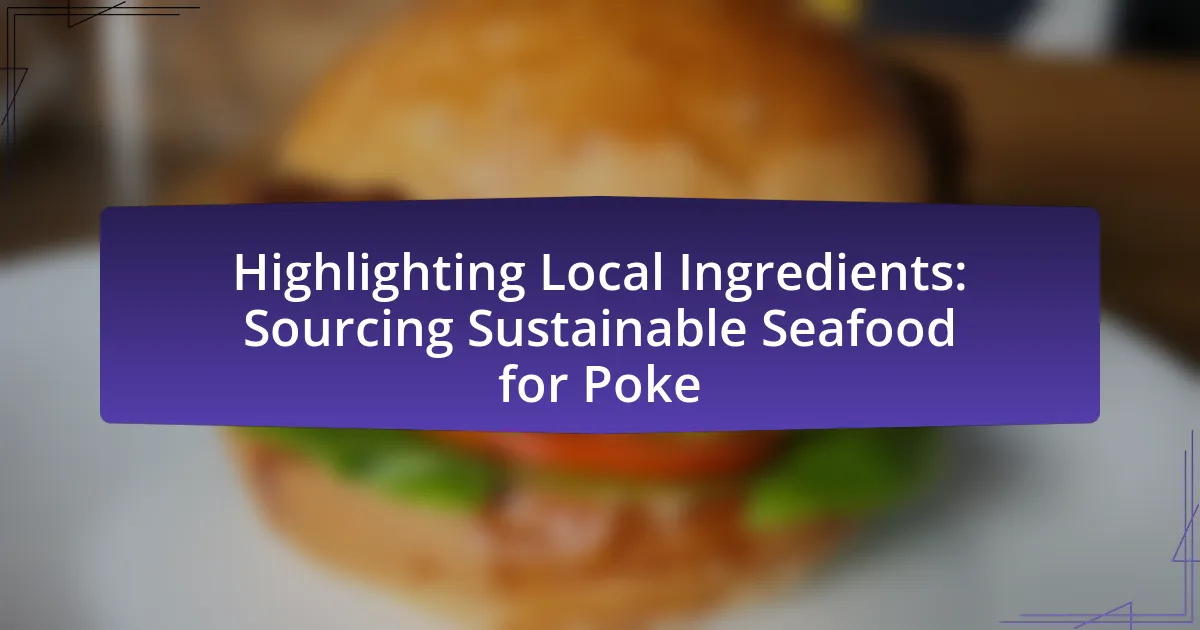The article focuses on the significance of local ingredients in sourcing sustainable seafood for poke, emphasizing their role in enhancing flavor, promoting sustainability, and supporting local economies. It discusses the environmental benefits of using locally sourced seafood, including reduced carbon footprints and the preservation of marine ecosystems. The article also outlines best practices for sourcing sustainable seafood, the challenges faced by restaurants in obtaining local ingredients, and the importance of community support in fostering sustainable seafood sourcing efforts. Additionally, it provides practical tips for consumers and restaurants to ensure responsible sourcing of seafood, highlighting relevant certifications and strategies for engaging with local fisheries.

What are Local Ingredients and Their Importance in Poke?
Local ingredients in poke refer to fresh, regionally sourced components such as fish, vegetables, and seasonings that enhance the dish’s authenticity and flavor. Their importance lies in promoting sustainability, supporting local economies, and ensuring the highest quality and freshness of the poke. For instance, using locally caught fish reduces the carbon footprint associated with transportation and helps maintain the local fishing industry. Additionally, local ingredients often reflect the cultural heritage of the region, providing a unique culinary experience that connects consumers to the area’s traditions and practices.
Why should we focus on local ingredients for poke?
Focusing on local ingredients for poke enhances freshness and supports sustainability. Local seafood is often caught and delivered quickly, ensuring optimal flavor and quality, which is crucial for dishes like poke that emphasize raw ingredients. Additionally, sourcing locally reduces the carbon footprint associated with transportation, contributing to environmental sustainability. Studies show that local sourcing can also bolster local economies, as it keeps money within the community and supports local fishermen and farmers.
How do local ingredients enhance the flavor of poke?
Local ingredients enhance the flavor of poke by providing freshness and unique regional characteristics that elevate the dish. The use of locally sourced fish, such as ahi tuna or salmon, ensures optimal freshness, which is crucial for the quality of poke. Additionally, local seasonings and toppings, like seaweed, avocado, and native fruits, contribute distinct flavors that reflect the culinary heritage of the region. For instance, using Hawaiian sea salt adds a mineral complexity that enhances the overall taste profile. This emphasis on local sourcing not only supports sustainable practices but also creates a more authentic and flavorful poke experience.
What are the environmental benefits of using local ingredients?
Using local ingredients significantly reduces the carbon footprint associated with transportation. When food is sourced locally, it typically requires less energy for shipping, which decreases greenhouse gas emissions. For instance, a study by the USDA found that food transported over long distances can generate up to 11 times more carbon emissions compared to locally sourced food. Additionally, local sourcing supports biodiversity by promoting the use of seasonal and native crops, which can enhance soil health and reduce the need for chemical fertilizers and pesticides. This practice also fosters sustainable farming methods, as local producers are often more invested in their communities and ecosystems, leading to better environmental stewardship.
What role does sustainability play in sourcing seafood for poke?
Sustainability is crucial in sourcing seafood for poke as it ensures the long-term health of marine ecosystems and supports responsible fishing practices. Sustainable sourcing involves selecting seafood that is harvested in a way that maintains fish populations and minimizes environmental impact, such as avoiding overfished species and using methods that reduce bycatch. For instance, the Marine Stewardship Council (MSC) certification indicates that seafood is sourced from fisheries that adhere to sustainable practices, promoting biodiversity and ecosystem balance. This approach not only protects ocean resources but also aligns with consumer demand for ethically sourced food, enhancing the overall appeal of poke dishes.
How does sustainable seafood sourcing impact marine ecosystems?
Sustainable seafood sourcing positively impacts marine ecosystems by promoting the health and resilience of fish populations and their habitats. This approach reduces overfishing, which can lead to the depletion of species and disruption of the food chain. For instance, sustainable practices often include measures such as catch limits and protected areas, which help maintain biodiversity and ecosystem balance. According to the Marine Stewardship Council, fisheries that adhere to sustainable practices can help restore fish stocks to healthy levels, thereby supporting the overall health of marine environments.
What certifications should consumers look for in sustainable seafood?
Consumers should look for certifications such as the Marine Stewardship Council (MSC) and the Aquaculture Stewardship Council (ASC) when selecting sustainable seafood. The MSC certification indicates that wild-caught seafood is sourced from fisheries that adhere to sustainable practices, ensuring fish populations remain healthy and ecosystems are preserved. The ASC certification signifies that farmed seafood is produced in a manner that minimizes environmental impact and promotes responsible farming practices. These certifications are recognized globally and provide assurance that the seafood meets rigorous sustainability standards, helping consumers make informed choices that support ocean health and responsible sourcing.

How to Source Sustainable Seafood for Poke?
To source sustainable seafood for poke, prioritize suppliers that adhere to recognized sustainability certifications, such as the Marine Stewardship Council (MSC) or the Aquaculture Stewardship Council (ASC). These certifications ensure that seafood is harvested or farmed in ways that maintain healthy ecosystems and fish populations. Additionally, engage with local fisheries and aquaculture farms that practice responsible fishing methods and prioritize environmental stewardship. Research indicates that sourcing seafood from well-managed fisheries can significantly reduce overfishing and habitat destruction, contributing to long-term sustainability in seafood supply chains.
What are the best practices for sourcing sustainable seafood?
The best practices for sourcing sustainable seafood include choosing seafood certified by reputable organizations, such as the Marine Stewardship Council or the Aquaculture Stewardship Council. These certifications ensure that the seafood is harvested or farmed in ways that maintain healthy fish populations and minimize environmental impact. Additionally, sourcing seafood from local fisheries can reduce carbon footprints associated with transportation and support local economies. It is also important to stay informed about seasonal availability and to avoid overfished species, as indicated by resources like the Seafood Watch program, which provides updated recommendations on sustainable seafood choices.
How can local fisheries contribute to sustainable seafood sourcing?
Local fisheries contribute to sustainable seafood sourcing by promoting responsible fishing practices and supporting local ecosystems. These fisheries often implement measures such as catch limits, seasonal closures, and habitat protection to ensure fish populations remain healthy and sustainable. For instance, according to the Marine Stewardship Council, fisheries that are certified sustainable adhere to strict environmental standards, which helps maintain biodiversity and reduces overfishing. Additionally, local fisheries can reduce the carbon footprint associated with seafood transportation, as sourcing seafood from nearby waters minimizes the distance products travel to reach consumers. This localized approach not only supports community economies but also fosters a connection between consumers and the source of their food, encouraging more sustainable consumption habits.
What questions should you ask suppliers about their seafood sourcing?
To ensure responsible seafood sourcing, ask suppliers the following questions: What is the source of the seafood, and is it wild-caught or farmed? Inquire about the sustainability certifications they hold, such as Marine Stewardship Council (MSC) or Aquaculture Stewardship Council (ASC). Request information on the fishing methods used and their impact on the ecosystem. Ask about traceability practices to confirm the seafood’s origin and handling. Additionally, inquire about the supplier’s policies on overfishing and their commitment to sustainable practices. These questions help verify that the seafood aligns with sustainability standards and supports local ecosystems.
How can consumers identify sustainable seafood options?
Consumers can identify sustainable seafood options by looking for certifications from reputable organizations such as the Marine Stewardship Council (MSC) or the Aquaculture Stewardship Council (ASC). These certifications indicate that the seafood has been sourced responsibly, adhering to environmental and social standards. Additionally, consumers can consult guides from organizations like the Monterey Bay Aquarium’s Seafood Watch, which provides recommendations based on sustainability assessments. Research shows that seafood with these certifications is less likely to contribute to overfishing and habitat destruction, making them reliable choices for environmentally conscious consumers.
What labeling systems indicate sustainable seafood?
Labeling systems that indicate sustainable seafood include the Marine Stewardship Council (MSC) certification, the Aquaculture Stewardship Council (ASC) certification, and the Best Aquaculture Practices (BAP) certification. The MSC certification signifies that wild-caught seafood is sourced from fisheries that meet strict sustainability standards, ensuring the health of fish populations and ecosystems. The ASC certification applies to farmed seafood, indicating that it is produced in environmentally and socially responsible ways. The BAP certification covers both farmed and processed seafood, ensuring adherence to comprehensive standards for environmental sustainability, animal welfare, and social responsibility. These certifications are recognized globally and help consumers make informed choices about sustainable seafood options.
How can consumers verify the sustainability claims of seafood products?
Consumers can verify the sustainability claims of seafood products by checking for certifications from reputable organizations such as the Marine Stewardship Council (MSC) or the Aquaculture Stewardship Council (ASC). These certifications indicate that the seafood has been sourced responsibly, adhering to environmental and social standards. Additionally, consumers can research the seafood’s origin, looking for transparency in supply chains, and consult resources like the Seafood Watch program, which provides recommendations based on sustainability assessments. These methods ensure that consumers make informed choices regarding the sustainability of their seafood purchases.

What are the Challenges in Sourcing Sustainable Seafood for Poke?
The challenges in sourcing sustainable seafood for poke include overfishing, lack of transparency in supply chains, and varying sustainability standards. Overfishing depletes fish populations, making it difficult to find seafood that meets sustainability criteria. Additionally, many suppliers do not provide clear information about their sourcing practices, complicating efforts to verify sustainability. Furthermore, sustainability certifications can differ significantly, leading to confusion about what qualifies as sustainable seafood. These factors collectively hinder the ability to consistently source seafood that aligns with sustainable practices for poke.
What obstacles do restaurants face in sourcing local seafood?
Restaurants face several obstacles in sourcing local seafood, primarily including availability, regulatory challenges, and price fluctuations. Availability can be limited due to overfishing, seasonal variations, and environmental factors affecting local fish populations. Regulatory challenges arise from compliance with local fishing laws and sustainability certifications, which can complicate sourcing efforts. Price fluctuations often occur because local seafood can be more expensive than imported options, influenced by supply and demand dynamics. These factors collectively hinder restaurants’ ability to consistently source local seafood for their menus.
How do seasonal availability and climate change affect seafood sourcing?
Seasonal availability and climate change significantly impact seafood sourcing by altering the populations and distribution of marine species. For instance, warmer ocean temperatures can lead to shifts in fish migration patterns, making certain species less accessible during traditional fishing seasons. Research indicates that species like cod and haddock have moved northward in response to rising sea temperatures, affecting local fisheries reliant on these species. Additionally, climate change can lead to more extreme weather events, disrupting fishing operations and supply chains. This variability necessitates adaptive sourcing strategies to ensure sustainable seafood availability, as demonstrated by the increasing reliance on aquaculture and local fisheries that can respond to these changes.
What are the economic implications of sourcing local versus imported seafood?
Sourcing local seafood generally supports the local economy by creating jobs and stimulating regional businesses, while imported seafood can lead to lower prices but may negatively impact local fisheries. Local sourcing often results in higher prices due to limited supply and higher operational costs, but it fosters sustainability and reduces transportation emissions. In contrast, imported seafood can be cheaper due to economies of scale and lower labor costs in exporting countries, but it may contribute to overfishing and environmental degradation. According to a study by the National Oceanic and Atmospheric Administration, local seafood sourcing can increase economic resilience in coastal communities by retaining more revenue within the local economy.
How can these challenges be overcome?
To overcome the challenges of sourcing sustainable seafood for poke, stakeholders must implement comprehensive sourcing guidelines that prioritize local fisheries and sustainable practices. Establishing partnerships with local fishermen who adhere to sustainable fishing methods ensures a consistent supply of high-quality seafood while supporting the local economy. Research indicates that sustainable seafood sourcing can reduce overfishing and promote marine biodiversity, as highlighted by the Marine Stewardship Council’s certification program, which recognizes fisheries that meet strict sustainability standards. By actively engaging in community education and awareness programs, stakeholders can further encourage responsible consumption and foster a culture of sustainability within the culinary landscape.
What strategies can restaurants implement to ensure sustainable sourcing?
Restaurants can implement strategies such as establishing partnerships with local fisheries and farmers to ensure sustainable sourcing. By sourcing seafood from fisheries that adhere to sustainable practices, restaurants can support local economies while minimizing environmental impact. For instance, the Marine Stewardship Council (MSC) certification indicates that seafood is sourced from well-managed fisheries, ensuring that fish populations remain healthy and ecosystems are preserved. Additionally, restaurants can adopt seasonal menus that highlight local ingredients, reducing transportation emissions and promoting biodiversity. Engaging in transparent supply chain practices allows restaurants to communicate their sourcing methods to customers, fostering trust and encouraging sustainable consumer choices.
How can community support enhance local seafood sourcing efforts?
Community support can enhance local seafood sourcing efforts by increasing demand for sustainably sourced seafood, which encourages local fishermen to prioritize environmentally friendly practices. When community members actively choose to purchase seafood from local sources, they create a reliable market that incentivizes fishers to maintain sustainable fishing methods. For instance, studies show that communities with strong local seafood movements often see a rise in the number of fishers adopting sustainable practices, as they respond to consumer preferences for fresh, local, and responsibly harvested seafood. This symbiotic relationship not only supports local economies but also contributes to the preservation of marine ecosystems.
What are some practical tips for sourcing sustainable seafood for poke?
To source sustainable seafood for poke, prioritize purchasing from certified fisheries that adhere to sustainable practices, such as those recognized by the Marine Stewardship Council (MSC) or the Aquaculture Stewardship Council (ASC). These certifications ensure that the seafood is harvested or farmed in ways that maintain fish populations and minimize environmental impact. Additionally, consult local seafood guides, like those provided by the Monterey Bay Aquarium, which offer recommendations on sustainable seafood choices based on regional availability and fishing methods. Engaging with local fishmongers or seafood markets can also provide insights into the sustainability of their offerings, as they often have direct relationships with local fishermen and can share information about the sourcing practices used.



